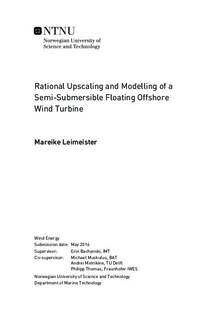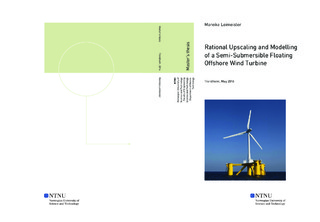| dc.description.abstract | Floating offshore wind turbines are taking on more and more prominence, as the industry moves towards larger turbines, farther offshore, in deeper water. The increase in turbine size can reduce the costs of offshore wind energy, but requires larger support structures. Rather than redesigning the structure completely, a rational methodology for upscaling an existing floating substructure can improve the efficiency of the design process. This work presents a guideline for the optimization and upscaling of a semi-submersible floating platform, addressing also special challenges related to changes in turbine technology, as well as design criteria for floating platforms.
The OC4 semi-submersible platform is used as starting point of this study. Based on analysis results of an initial elementary upscaling procedure, the main criteria, when dealing with a semi-submersible floating platform, are specified. Optimization is then carried out, focusing on stability and eigenfrequencies. Reducing the upper column diameter and changing the ballast position within the columns, yields longer natural periods in heave and pitch, a lighter and cheaper platform, and a less over-conservative, but still stable and safe system.
Based on this optimized design, a guideline for an upscaling procedure for any other turbine is given. The main scaling factor is determined from the mass ratio of the top structures, rather than the turbine rating. The main column is scaled, so that it fits the new tower base diameter. The scaling factor for the upper columns is computed, based on the ratio of the overturning moments, and considers the contribution of the different columns to the stiffness component in pitch. The mooring line length is scaled, such that it can yield a predefined stiffness. Finally, the controller gains are recalculated, based on the expected natural frequency in pitch.
The optimization and upscaling process is carried out for Fraunhofer's offshore wind turbine IWT-7.5-164 and the DTU 10 MW reference wind turbine. The floating wind turbines are analyzed, modelled and simulated by means of simplified spreadsheet methods, linear frequency-domain calculations (in DNV's software HydroD), and detailed equation-based models (in Fraunhofer's software Modelica). The systems are evaluated regarding their eigenfrequencies, nominal pitch, stability and global performance in selected sea states, taking variable buoyancy and center of buoyancy into account, and adjusting the blade-pitch controller gains. The results, obtained from both computer programs and the initial hand calculations, are comparable and satisfying. The structural integrity is proved by a simplified approach, using tank pressure and sea pressure for computing the equivalent stress. More detailed strength checks for fatigue and ultimate limit states, as well as optimization of the mooring system, are left for future work. | |

